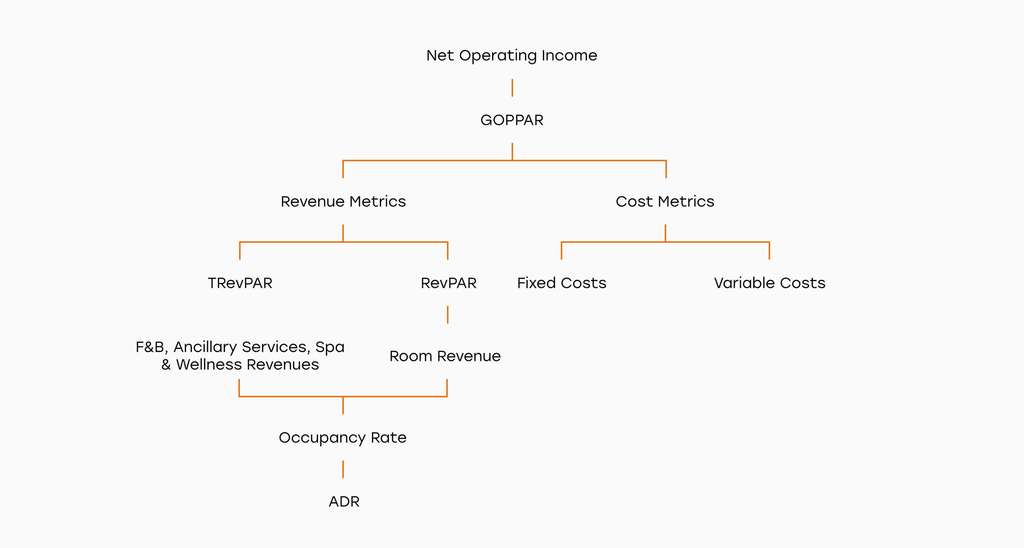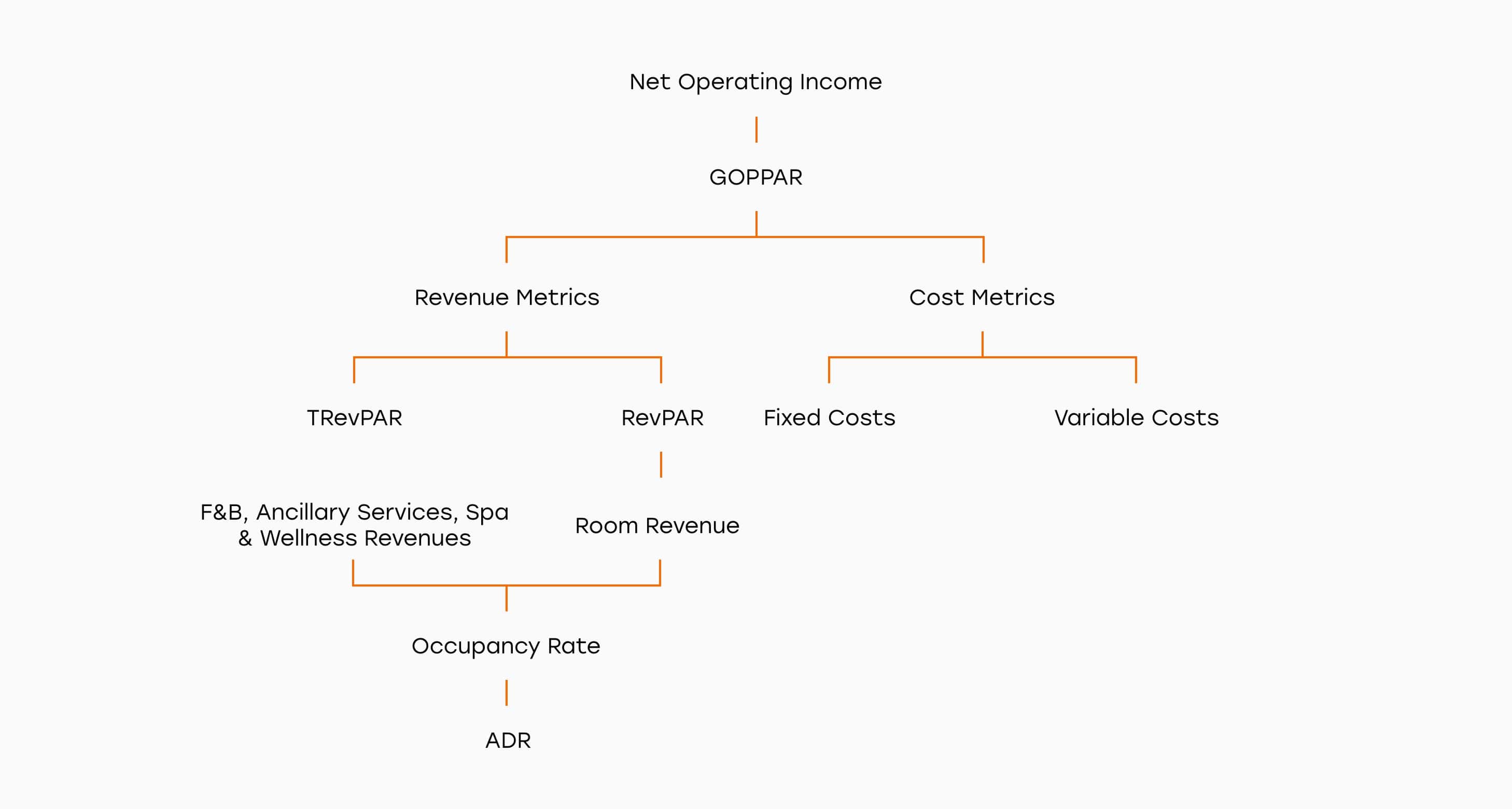The Top Five Hotel KPIs in 2021

Throughout this pandemic, hoteliers everywhere had to find ways to successfully navigate times of unpredictable and often decreased demand compared to previous years.
Adapting to shifting consumer trends as well as finding new ways to drive demand and reduce non-value-adding expenses became paramount for a hotel's survival. This led to subtle shifts in many revenue managers' attitudes towards hotel KPIs (key performance indicators).
Read on for an overview of how the importance of hotel KPIs is changing and which ones will be most critical for hotels in 2021 and during Covid-19 in general.
Finding a new North Star
RevPAR's status as the North Star metric seems to have diminished significantly. Instead, driving net operating income (NOI), gross operating profit per available room (GOPPAR) and total revenue per available room (TRevPAR) have moved into the spotlight. This shift highlights how revenue managers have moved on from looking at a single metric to taking a more holistic view of their business, which is a smart move, especially in these times.
Having said that, this shift goes beyond simply replacing one North Star metric with another. You must decide which key metrics you want to monitor, how KPIs are connected and how to tweak each one to reach your goal.
As an example, hotels can work on cutting expenses where possible by reducing labour or operational overheads to a level just sufficient to accommodate the few guests staying with them. At the same time, they explore ways to maximise revenue streams and increase TRevPAR. While this will positively impact NOI and GOPPAR, it's much easier said than done.
A new key idea: driving NOI
While the concept of increasing revenue metrics and optimising costs to drive NOI may seem straightforward, it can be challenging to realise.
In the foreseeable future, demand and revenue will likely remain unpredictable while many hotels have lowered their average daily rates (ADR) to boost occupancy rates. The only chance to drive NOI in this scenario is for revenue managers to work with other departments to increase revenue metrics all while keeping costs low. This means focusing more on TRevPAR and GOPPAR over RevPAR in a time where maintaining cash flow is the key to survival.
Keep reading for insights into how this new perspective can mean the difference between success and failure for your hotel and learn which KPIs deserve extra attention in 2021.
Net Operating Income
Net operating income is a hotel's revenue generated minus its operating expenses, i.e. the money left after deducting all operating expenses. It's an important metric for hotel owners and investors when they analyse a property. NOI also allows hotels to build a buffer that helps them survive times of slow business like the current crisis. Properties without this financial cushion will need to focus extra hard on maximising profits from every little bit of pick-up.
It's challenging to impact NOI as a KPI since it's the result of all other KPIs combined. The only way to achieve this is when the revenue manager works with other department heads to boost TRevPAR and reduce variable costs in the short term without impacting service quality.
Revenue Managers should, however, exercise caution when adjusting levers such as ADR to drive revenue because this will impact other KPIs such as occupancy rates. The best place to start is to determine a minimum profit goal for your property. From there, you can set goals for related KPIs such as GOPPAR, TRevPAR, RevPAR, ADR, occupancy rate and online review scores.
GOPPAR
GOPPAR stands for gross operating profit per available room. If you only want to track a single metric to track your success during today's crisis, it should be a profit-oriented one like GOPPAR because it gives you a bird's eye overview of how your property is doing.
GOPPAR does two important things. First, it shows you how revenues and expenses are distributed per team, down to the bottom line. Second, it highlights inefficiencies which are getting in the way of your profit goals.
You can increase GOPPAR in several ways. Tweak ADR rates to impact your occupancy at minimised expenses and maximise your TRevPAR. Be aware though, that lowering rates can boost occupancy in the short term but can lead to lost profits in the mid-term if you don't push TRevPAR. Keep your fixed minimum cost per guest and room in mind as well when you adjust ADR. Use creative ways to further reduce this cost by getting your guest's help. For example, you can offer them a low-cost freebie (e.g. a round of drinks or pizza on the house) if they opt out of daily housekeeping and laundry services.
TRevPAR
A refined TRevPAR strategy is more important for your hotel during this crisis than ever before. TRevPAR looks at the total revenue generated per available room. This includes everything from the basic room rate, paid upgrades, F&B add-ons (e.g. breakfast), and ancillary spending in all hotel departments.
RevPAR (revenue per available room) used to be the North Star metric for revenue managers. However, when comparing RevPAR to TRevPAR, it's apparent that RevPAR only looks at a small area of the hotel instead of the bigger picture of maximising revenues and profits property wide. A shift towards this more complete overview is necessary to drive profits, especially since 'post-lockdown' travellers want more creative and experiential services which involve all hotel departments.
TRevPAR offers this comprehensive view because it recognises all departments as potential sources of revenue. Once revenue managers see this potential as well, they can work with other department heads to create attractive packages or a smart in-person/digital upselling strategy.
When working on driving TRevPAR, know your NOI goals first. Then look at how you can drive revenue from F&B, parking, ancillary services, spa services, or any other activities guests could spend on. Could you create value-packed service bundles that are attractive to budget-conscious guests? How about an extravagant four-course room service dinner for guests who book your suites?
Occupancy rate
Occupancy rate indicates the percentage of available room sold during a certain time. Having a clear profit goal will help revenue managers determine the minimum occupancy rate needed to break even or bring in a profit. While occupancy will always be an important KPI, always look at it in the context of other KPIs.
For example, how will high occupancy rates impact your TRevPAR and cost metrics? Dropping your ADR to achieve a 100% occupancy rate may look good on paper because it results in a short-term revenue boost. However, you risk missing out on revenue by filling your hotel with guests who have low TRevPAR potential. Serving these guests will incur similar costs as those with higher TRevPAR potential which could lower your NOI. Before adjusting rates, always think about whether you should focus on the quality or quantity of guests since there's a time for everything. Also, don't forget that increasing your rates again later may be harder than expected and result in throwing off your positioning in the medium term.
ADR
The ADR or average daily rate is calculated by dividing the number of rooms sold by the revenue they generated. Hoteliers mainly use this KPI to compare their properties' past performance and benchmark themselves against their compset. Revenue managers also leverage ADR to influence occupancy rates (as outlined above).
As a revenue manager, your goal should be to boost your ADR incrementally, by refining your hotel's branding, improving its reputation, infrastructure and packages. The higher the ADR your hotel can demand, the higher the quality of guests you'll attract. They will have a higher spending capacity which can help you increase your TRevPAR by promoting ancillary services in other departments. If you want to drop your ADR slightly to capture market share, use pre-arrival or in-stay upselling to make up for the lower room rate and drive TRevPAR.
Sentiment scores on online review sites
A sentiment score aggregates online reviews and is comparable to an NPS score (net promoter score) i.e. how likely someone is to recommend your hotel. Especially Millennials and Gen Z check online reviews when planning a trip. This makes review sites a free sales and marketing tool for your hotel that can drive significant business if guests share the amazing experience and ancillary services offered to them.
Your sentiment scores also impact whether guests will be willing to pay your high ADR, so do your best to stand out and showcase your property. Think about ways you can delight your guests, so they'll leave glowing reviews that will encourage even more people to book with you. Use a social media monitoring tool (or keep an eye on things manually) to track guest ratings and comments on sites like TripAdvisor and similar platforms.
Bringing it all together
Looking at KPIs individually is like looking at a single piece of a puzzle. If you want to improve a bottom-line KPI (like NOI), you must first improve the leading top-line KPIs (like TRevPAR) to get results down the line.
Start with your end goal in mind and work backwards to see where you can start making changes to get your desired results, which, today include making it through the crisis and getting the most out of the recovery phase once it begins.
Remember that competition will be fierce due to decreased demand. The good news for you is that post-lockdown travellers will be keen on spending money on memorable experiences. Think about how you can use your existing resources to offer this. It doesn't always have to be something huge. A simple hand-written welcome card or thank you note is an impactful and low-cost way to start. Once your guests have had an unforgettable stay experience, they will spread the word among family, friends and on social media.
You can get started on this journey today by making small but meaningful changes. For example, consider updating your packages, adjusting your ADR, introducing an in-person or automated upsell strategy to boost TRevPAR or finding new ways to better manage costs to improve your GOPPAR and NOI.
About Oaky
Oaky is a hyper-personalised upselling software that helps hotels boost revenue through enriched guest experience and branding. Enabling hotels to leverage segmentation, personalisation, dynamic pricing and more, Oaky takes upselling services and upgrades to the next level, maximising the average spend per guest and taking the legwork out of the upselling process. Oaky has been recognised as the Best Upselling Software by Hotel Tech Report for 5 years in a row and is trusted by innovative hotels, groups and chains across the globe, including the ONYX Hospitality & Radisson Hotel Group.
Anastassia Kravtsenko
PR & Events Manager
+31625332217
Oaky

